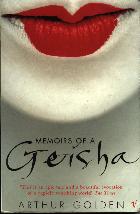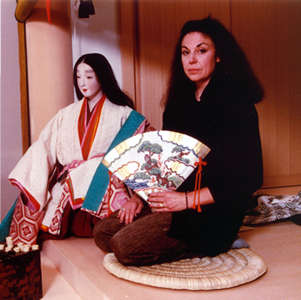Geisha
 All Geisha Girl - an exclusive Femail interview with Liza Dalby
All Geisha Girl - an exclusive Femail interview with Liza Dalby
Liza Dalby is the only foreigner to ever beome a Geisha...
- How would you compare the life of a 11th century geisha with that of 21st century geisha?
We need to be careful not to confuse Murasaki with geisha. Murasaki was an 11th century court lady-geisha were not part of Japanese society until the 17th century. They arose as entertainers in the licensed quarters of the major cities. In fact, the first geisha were men, and women didn't dominate the profession until later. The real golden age of the women geisha was the 19th century. The most striking difference between today's geisha and the past is that now no-one is forced into this life.
- It's fascinating that Poetry was the primary mode of communication amongst the people Murasaki associated with. What are the ramifications of speaking in verse compared to standard conversational techniques?
Courtiers in Murasaki's day were all expected to know the conventions and be able to produce the 31-syllable waka verse for public and private occasions-but conversation (including joking, innuendo, and the ability to tell a good story) was highly valued as well. Poetry was always set aside from prose as a special kind of communication, usually written, and often accompanied by a letter.
- What would you say were the key strengths and weaknesses of Murasaki's persona?
Murasaki was amazingly observant and had a rare ability to work her observations into her writing. My impression is that, like many writers, she had a rich interior life, suffered a lot of self-doubt, and was often difficult to be around.
- You speak of using 'Literary archaeology' as the method of piecing together Murasakis life. What were the primary challenges of this technique?
As far as I know, "literary archaeology" is a term I invented to describe what I was doing. The challenge was trying to make the parts of the tale I invented fit in with what we do know about the historical Murasaki Shikibu.
- What would you say is the most important thing women today can learn from Murasaki's plight?
My view of Murasaki was to see her as overcoming the various disappointments of her own life through creatively engaging herself in writing and coming to a greater self-awareness through this process. In a way, her story is a cautionary tale about what can happen when you get what you want.
- Do you think westernised women could benefit from certain values a Geisha holds. If so, could you give some examples?I was very impressed by the number of geisha I met who were of course very feminine, but also very forthright and had a strong sense of themselves as artists. My experience ran completely contrary to a western fantasy that thinks of geisha as submissive. Geisha are also very good at "people skills". In a party situation they know how to draw another person out and make them feel good about themselves. I admire their ability to be both empathetic and sure of themselves-I think ultimately this is where their appeal lies, and it is something western women could indeed emulate.
- Why do you think you are the only foreigner to become accepted as a Geisha?
It's not the sort of thing that many western women have the background for. In my case, I had studied shamisen for ten years prior to my geisha experience. Because I could play that instrument, the geisha were inclined to take me more seriously. Also, I never intended to actually become a geisha when I started my research. I was invited by the geisha to join them after I had been there more than six months doing interviews.
- Are you saddened, by what you describe as what will be an inevitable decrease of Geisha in Modern society?
Geisha are used to the ups and downs of the economy that greatly affect their livelihood. Their numbers are already quite small but I don't think they will disappear.
- Would you agree that the true Geisha may be lost, in time and the Geisha in say the year 2050, may simply be just a tourist token?
It's hard to talk of a "true geisha". Part of the interest in this profession is the fact that there is so much regional variation. Also, geisha are no longer the popular entertainers they originally were and in some ways have been icons of tradition since the 1950s. I imagine that in some form or other, geisha will still be around in another 50 years, and they will not likely be simply a tourist attraction.
- How do you respond to a woman who insists the Geisha way is outdated and even holds back equality of the sexes?
Of course it is outdated-but that is part of its appeal to some women. In traditional society, being a geisha was a way for a woman to follow her own career and make her way in life without having to marry. Now there are many more options for women, and being a geisha is seen as too difficult and too constricting. The idea of geisha as submissive slaves to male whim is western fantasy and has little to do with notions of equality between the sexes in Japan.
- In relation to working along side Steven Spielberg on Memoirs of a Geisha, are you confident it has been represented truly, and not sensationalised too much?
I've been hired as a consultant to the film but the project is currently on hold. It will be very interesting to see how it develops. I think if anyone can make a movie with integrity on this subject, Spielberg can.
- Your books along with Arthur Goldens 'Memoirs of a Geisha' have been hugely successful, why do you think western culture is so fascinated by Geisha?
I think geisha have had a special place in the western imagination ever since the 19th century. To men they are seen as mysterious and exotic, and provoke fantasies of sexual allure. I think western women are drawn to the idea that geisha live in communities of women, do not marry, wear glamorous clothing, and devote themselves to art. Geisha live out of the mainstream and are, in fact, fascinating. Liza Dalby, author of The Tale of Murasaki, is the only nono japanese women ever to have become a Geisha. This is her unique insight into the extroadinary world of grace, beauty and tradition that has long fascinated and enthralled the west. Taking us to the heart of a way of life normally hidden from public gaze, Liza Dalby shows us the detailed reality that lies behind the bestselling Memoirs of a Geisha and opens our eyes to an ancient profession that continues to survive in today's modern Japan.
- Paul Fischer
MORE



